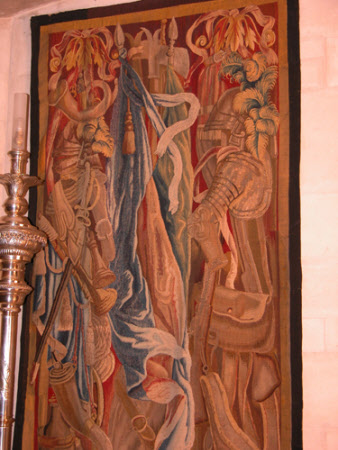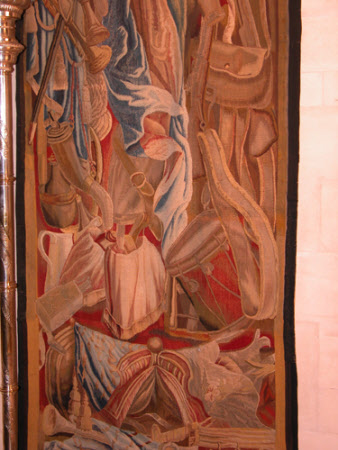The Art of War: Entrefenêtre
Brussels
Category
Tapestries
Date
circa 1690 - circa 1730
Materials
Tapestry, wool and silk, 7½ warps per cm, linen strip support, on poppers.
Measurements
2.26 m (H); 0.8 m (W)
Place of origin
Brussels
Order this imageCollection
Anglesey Abbey, Cambridgeshire
NT 516776
Summary
Tapestry, wool and silk, 7½ warps per cm, The Art of War: Entrefenêtre, Brussels, c. 1690-1730. A narrow vertical panel filled with military paraphernalia. At the bottom are a saddle, flags, flasks, drums and trumpets. Above in the centre of the tapestry are two large banners on poles with gold tassels and two axe heads between them. To the left of the banners are pieces of armour, flags, weapons and musical instruments, and to the rights more armour, a plumed helmet and a satchel. Red curtains hang behind the armour, tied with ribbons to two golden acanthus-leaf decorations at the top of the tapestry. The tapestry has no border as such but is surrounded by a plain beige band and a dark brown galloon.
Full description
Although the tapestry was woven as one piece its symmetrical design has the appearance of two sections of border joined together. In fact many of the details relate closely to elements found in the borders of a tapestry series known as the 'Art of War', first woven in Brussels in the 1690s. The upper left hand part of the tapestry, with a helmet at the top and a curved horn and a flask at the bottom, and the facing right hand section with a suit of armour and a satchel, both appear in reverse on the left hand border of a tapestry of 'The Surrender' from the 'Art of War' series, now at the Fondation Toms Pauli, Lausanne (Delmarcel 2010, cat. no. 45, pp. 132-5). The drums, pitchers, saddle and flags in the lower part of the tapestry and the banners in the upper centre can all be found in horizontal borders for other tapestries in the 'Art of War' series. The original 'Art of War' series, depicting the regular operations of an army at war, was designed by Lambert de Hondt (1650/60-1711) and woven in Brussels in the 1690s by Heironymous Le Clerc (1643-1722) and Gaspar van der Borcht (1675-1742). The subject proved immensely popular amongst European princes and nobility at a period when many were at war, and as many as eleven sets are known to have been made. Famously the Duke of Marlborough bought a set and many of his generals followed suit. Marlborough then commissioned a new tapestry series celebrating his own victories in Europe, designed by Lambert de Hondt's son Philip (1683-1741), and woven c. 1712-17 in Brussels by the entrepreneur Judocus de Vos (Bapasola 2005, pp. 70-133; Bapasola in Campbell 2007a, pp. 471-6). De Vos then created another, updated series of the 'Art of War' known as the 'Art of War II', using de Hondt's original designs and borders of the 1690s and incorporating some of the scenes from Marlborough's set of 'Victories', but without specifying the events depicted. The 'Art of War II' series was also incredibly successful, and thirteen sets are known to have been woven, many of which survive (Delmarcel 1999, pp. 342-51; Brosens in Campbell 2007a, pp. 477-83). The panel at Anglesey Abbey may have been woven to accompany a larger set of 'Art of War' tapestries, the use of border elements from the set allowing it to harmonise with the larger panels. The tapestry was probably intended as an entrefenêtre, a narrow panel designed to fill the space between widows in a large room. The unusual size of the tapestry, which is significantly reduced in height when compared to existing full-sized panels from the 'Art of War' series, suggests that it is the result of a specific commission. Both generations of the 'Art of War' series used the same borders, so it is difficult to tell which the tapestry at Anglesey Abbey belongs to. (Helen Wyld, 2011)
Provenance
Bequeathed to the National Trust by Huttleston Rogers Broughton, 1st Lord Fairhaven (1896-1966) with the house and the rest of the contents.
Credit line
Anglesey Abbey, The Fairhaven Collection (The National Trust)
Makers and roles
Brussels , workshop Lambert de Hondt (1655 - 1708), designer
References
Delmarcel, 2010: Guy Delmarcel, ‘The Flemish Tapestries’, in Guy Delmarcel, Nicole de Reyniès and Wendy Hefford, The Toms Collection Tapestries of the Sixteenth to Nineteenth Centuries, Zürich 2010, pp. 25-157 Campbell, 2007a: Thomas Campbell et al., Tapestry in the Baroque: Threads of Splendor, exh. cat. Metropolitan Museum of Art, New York 2007 Bapasola, 2005: Jeri Bapasola, Threads of History: The Tapestries at Blenheim Palace, Lydney 2005 Delmarcel, 1999: Guy Delmarcel, Flemish Tapestry, Tielt 1999


